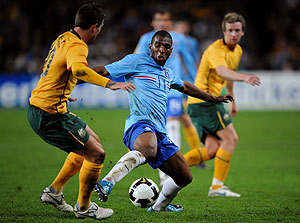
Australia's Harry Kewell (left) competes for the ball with Eljero Elia of the Netherlands during the Socceroos v Netherlands soccer match at the Sydney Football Stadium in Sydney, Oct. 10, 2009. The teams drew 0-0. AAP Image/Paul Miller
It’s time again to take off your club colours and slap on the green and gold. Another FIFA international date is upon us, and thankfully even the A-League is stepping aside for a week – though not the National Youth or Women’s Leagues.
There probably hasn’t been as important a FIFA international date since this time four years ago.
By the end of Saturday, the final World Cup spots will have been decided, we’ll know exactly how much Brazil have humbled England by (despite, according to FourFourTwo, the English having four of the twelve best players in the world compared with Brazil’s one), and the Socceroos will pretty much have their last major run-out until South Africa.
It’s the last of these points that I’ve been thinking about as the latest Socceroos squad makes for some interesting reading. Or more specifically, the omissions and inclusions do.
The biggest feature, obviously, is the absence of Scott McDonald.
So here’s what we know: Socceroos coach Pim Verbeek decided long ago that a cautious 4-2-3-1 was the best formation to utilise Australia’s abundance of wide forwards (Bresciano, Emerton, Kewell …)
There’s also a glut of central and, as Verbeek likes to refer to them, ‘controlling’ midfielders, to shield the centre-backs, which is necessary for this formation.
The other point that has now become obvious is that this squad is being built around Tim Cahill.
There’s no doubt he’s Australia’s biggest threat, and clearly Verbeek is trying to harness his quality as much as possible. That’s why the Socceroos coach has decided to go with Kennedy upfront.
McDonald’s omission is the final admission of that.
So with this structure in mind, we can start to consider the make-up and potential of the Socceroos squad that will head to South Africa next year.
For me, depth seems to be the biggest problem. Looking over recent Socceroos squads, three areas standout.
STRIKERS
Kennedy’s return to form in Japan has been heart warming for any Australian, but what if he picks up an injury?
For the last two years, we’ve just assumed that McDonald would come good eventually. However, Verbeek has now run out of patience with him.
While the door isn’t entirely shut on the Celtic striker, who would feel comfortable with him starting up front in South Africa?
Beyond him, there is the future promise of Bruce Djite and Nikita Rukavytsya but neither has proven to be ready for international football.
Beyond Mile Sterjovski, I agree with Jesse Fink’s point on Friday that striking options from the A-League pool “have virtually zero chance of making the final 23-man squad for the World Cup”.
The backup option for Verbeek then will most likely be playing Kewell out of position as a sole striker.
GOALKEEPERS
The return of Brad Jones and Adam Federici to this week’s Socceroos squad highlights Verbeek’s indecisiveness on the backup goalkeeper position.
No one, other then Adelaide United’s Eugene Galekovic, has had the chance to show their wares.
Still, if incumbent goalkeeper Mark Schwarzer picks up an injury before the World Cup, who would be comfortable with any of the players who’ve made squads over the last few years standing in goal in a high pressure World Cup game?
CENTREBACKS
I believe this is the position which will decide who are successful at next year’s World Cup. Not because I think it will be a defensive tournament, but for the exact opposite reason.
The UEFA Champions League is where the most tactically advanced football is being played and there is a clear trend being played in Europe – sides are playing one man up front.
This is becoming prevalent in international football, as well, and will feature predominantly at the business end of the tournament.
When a flat four comes up against a lone-forward, one centre-back is freed up, and while the other covers the sole striker, the other is freed.
What do you do with this free man?
While defensive forwards have been all the rage recently, I think attacking defenders are the next development.
The seething brain of tactical knowledge that is Jonathon Wilson wrote in the latest edition of Champions magazine that the libero could be about to return.
Remember Gerard Pique’s marauding runs for Barcelona last season? I saw a similar move from William Gallas lead to the opener for Arsenal against Brett Holman’s AZ Alkmaar at the Emirates on Wednesday night.
Even Juventus’ clumsy centre-back Giorgio Chiellini was continuously pushing on to great effect against Atalanta on Saturday.
Lucas Neill is capable to a point of playing this role (look up the goal Neill set up for Louis Saha in Everton’s debut) but beyond him who can? I remember with pleasure Matthew Spiranovic’s run from defence that finished with a shot on goal during the Beijing Olympics.
But few others have shown that ability.
So my fear, especially if Neill gets injured or suspended, is that Australia will miss out on utilising this potential advantage in South Africa.
The Socceroos’ squad depth looks fragile and there are few places on the pitch where quality injury cover will be easy to find. Verbeek is continuing to experiment with his squad, but time is about to run out.





























































































